Currents: teaching from the roots up
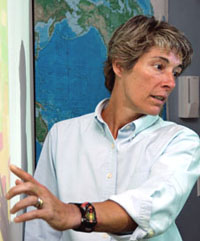 Prof. Laura Alexander and the State of New Hampshire.
Prof. Laura Alexander and the State of New Hampshire.Laura Alexander's Natural Classrooms
Laura Alexander's teaching methods take her far from the traditional classroom. To truly understand the places where we live, she says, you have to start with what grows there.
“Students in environmental studies need to have a foundation in what actually grows in a place,” says Laura Alexander, assistant professor of natural sciences. “They need to know what is supposed to be there and what is not supposed to be. As environmentalists, we need to know what has changed. If we are attentive to change, we will ask questions.
“The reason I teach flora is that if you know the plants you can predict the other species. You might wait quite a while to see a fox come out or a particular kind of bird. But if you know the flora and what other life it supports, then you can predict whatever else will be there.”
When it comes to teaching plant life to a beginning college class, though, traditional printed field guides pose some problems for students. They include dozens of species a student will never see near the campus, and they might avoid local varieties and variations. Alexander set out to fix all that when she created the Virtual Herbarium for her classes.
Alexander's on-line guide, with its clear descriptions and spectacular photographs, most of them taken in the wilds near the college by Alexander herself or her students, is limited to plant species and varieties native to or common in the New London area. Its narrow, specific focus has proved popular with all sorts of people in the Lake Sunapee-Dartmouth Region.
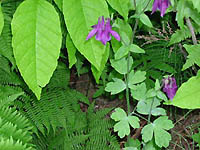 Garden or European Columbine (Aquilegia vulgaris) Buttercup Ranunculaceae family.
Garden or European Columbine (Aquilegia vulgaris) Buttercup Ranunculaceae family.Wild Classes
Traditional herbaria---collections of pressed and preserved plants labeled and classified for reference---were potent teaching tools for 19th-century botanists. So is their “virtual” descendant. Alexander's introductory students learn 66 woody plants and shrubs. Later that list grows to 88 species of all kinds.
“The first time around, I make it easy,” Alexander says. “I give them a quiz from the herbarium photos. Of course they end up memorizing the pictures but the first time around that's O.K.
“For the second round, we go outdoors. That time the students have a blank piece of paper with 88 numbered rows. As we walk around I'll say, 'This one is 46, this one is 18, here's another number 46.' And the students fill in the blanks.”
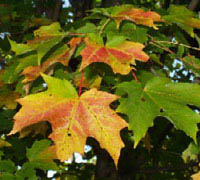 Sugar Maple (Acer saccharum)
Maple Aceraceae family.
Sugar Maple (Acer saccharum)
Maple Aceraceae family.In Alexander's more advanced land and resource management classes, plant study helps give each student an individual sense of connection.
“Across the street, in the Kelsey Forest, each student gets a 100 by 100 foot tract to study. I am quite intentional about cultivating a sense of place for them.
"Sometimes they develop that through the weekly practice of having to identify all the species and talk about the animal tracks, if they saw any, and what kind of animals made them, knowing what kind of birds live there, drawing what's in there, watching the seasons change, getting a real sense of that place.
“I tell them Colby-Sawyer College is going to be their home for these four years, and they can always come back to their tract.”
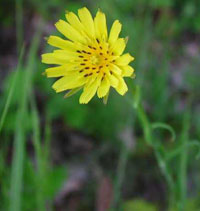 Yellow Goat's-Beard (Tragopogon pratensis)
Aster Asteraceae family.
Yellow Goat's-Beard (Tragopogon pratensis)
Aster Asteraceae family."Unique and Enthusiastic Teaching"
Alexander's methods have found their mark in her students. "Laura did a wonderful job conveying her enthusiasm for local flora to all the students in [my courses], says Steven Hash '07. "A requirement was to learn approximetely 90 different species of flora, both common and scientific name. While this task seemed daunting at the beginning of the first course, by the end of the second, we were all 'experts.'"
Matt Urban '07 speaks of Alexander's "unique and enthusiastic teaching style... Her love for teaching flora has grown beyond the classroom, now on a virtual herbarium and outside the class this summer as she taught an Alpine Flora class."
Finding Your Place
Alexander, a Colby-Sawyer alumna and New Hampshire native, leads walks for local conservation groups and trips for the Appalachian Mountain Club as well as teaching her out-of-doors classes at Colby-Sawyer. For her, nature is always an eye-opening classroom.
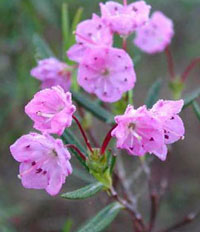 Pale or Bog Laurel (Kalmia polifolia)
Heath Ericaceae family.
Pale or Bog Laurel (Kalmia polifolia)
Heath Ericaceae family.“My students are always kind of surprised to learn about what they have missed, what they haven't been paying attention to all their lives. They are surprised to learn that trees flower, to learn about the variety of what's here. They know there are maple trees but are surprised to learn there are five maples, surprised to learn there are four birch trees.
“They get really excited when they make those discoveries. They want to share them with friends, to go home and tell families. Before they came to ask those questions I teach about the environment; the landscape may have been more of a backdrop.
“I tell students all the time: When we arrive in new places we settle ourselves in them by getting to know the people and the organization of the built setting. Another way you might get to know a place is by grabbing a field guide and getting to know what grows in that place. It might be a good way to organize yourself in any new place you might land.”
-PETER WALSH
Questions or comments on this story? Click here to send us an e-mail.


